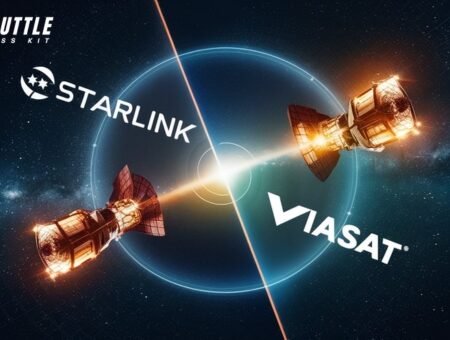Choosing between Starlink vs. Viasat can be a tough decision. With both offering satellite internet, they each have their own strengths and weaknesses. One might seem faster, while the other could be more reliable.
In this blog post, I’ll help you find out which one suits your needs best. Whether you need high-speed internet for work or just want to stream videos without any hiccups, keep reading! You’ll get a clear picture of what each service offers and how they stack up against each other in real-life use.
Viasat vs. Starlink – A Quick Introduction
Viasat and Starlink are prominent competitors in the satellite internet market, each offering unique advantages. Starlink is known for its high-speed internet, with download speeds reaching up to 220 Mbps, thanks to its low-Earth orbit satellites that provide lower latency.

This makes it ideal for activities like online gaming and streaming. However, Starlink comes with a higher starting price of around $120 per month and significant equipment costs. In contrast, Viasat offers more affordable plans starting at approximately $69.99 per month, with speeds up to 150 Mbps.
Viasat covers a broader range of addresses, making it a reliable choice for users in rural areas. Ultimately, the choice between the two will depend on individual needs for speed, price, and coverage.
Also Read: Starlink vs HughesNet: Which Wins the Satellite Battle?
Price
In terms of price, Viasat generally offers lower starting rates compared to Starlink. Viasat’s plans begin at around $64.99 per month, while Starlink’s standard plan starts at $120 per month.
Although Viasat provides a more affordable entry point, it’s essential to consider the overall cost, including potential fees for exceeding data limits. Starlink, while pricier initially, does not impose contracts, allowing users to cancel without penalties.
Additionally, Starlink requires a significant upfront equipment cost, which can reach up to $599, whereas Viasat offers a leasing option for its equipment at a lower monthly fee. For budget-conscious consumers, Viasat may be the more appealing choice.
Speed
When it comes to speed, Starlink outperforms Viasat. Starlink offers maximum download speeds ranging from 20 Mbps to 220 Mbps, with many users experiencing speeds between 100 Mbps and 150 Mbps.
In comparison, Viasat provides speeds up to 150 Mbps, but these speeds are not consistently available in all areas. Starlink’s use of low-Earth orbit satellites results in lower latency, enhancing the user experience for activities like online gaming and video conferencing.
While Viasat has a long-standing reputation for satellite internet, Starlink’s faster speeds and lower latency make it a superior option for users requiring high-performance internet.
Reliability
In terms of reliability, both Viasat and Starlink have their strengths. Starlink is known for its low latency, which can enhance the overall user experience, especially for real-time applications.
However, its service may be affected by environmental conditions, such as heavy rain or snow. Viasat, on the other hand, has established a reputation for consistent service over the years, particularly in rural areas.
While Viasat’s speeds may fluctuate based on network congestion, it generally provides a stable connection. Ultimately, users in need of reliable internet might lean towards Viasat, while those prioritizing speed and low latency may prefer Starlink.
Coverage
Coverage is another critical aspect when comparing Viasat and Starlink. Viasat has a well-established network, providing service to virtually all areas across the United States, including many remote locations.
Its long history in the satellite internet market allows it to reach a broad customer base. Starlink, while also available in many regions, has historically had limited availability, although it is expanding rapidly.
Starlink’s unique selling point is its mobility options, allowing users to access the internet on the go with its Roam plans. For users in remote areas, Viasat may offer more reliable service, while Starlink is appealing for those needing portable internet solutions.
Also Read: Starlink Offer Phone Service? Discover Now!
What is the main difference between Starlink vs. Viasat?
Starlink primarily utilizes a low Earth orbit network for quicker internet speeds, whereas Viasat operates in a geostationary orbit, focusing on stability over a wide coverage area.
Can I use Starlink vs. Viasat in remote locations?
Yes, both Starlink vs. Viasat are designed to provide internet access in remote and rural areas where traditional broadband services might not be available.
Which is more expensive, Starlink or Viasat?
The cost varies based on the plans and equipment fees. Starlink typically has a higher upfront cost for equipment, while Viasat might offer different plans that could impact monthly fees.
How fast can I expect my internet to be with Starlink compared to Viasat?
Starlink generally offers faster speeds due to its network of low Earth orbit satellites, while Viasat’s speeds can be affected by its geostationary satellite’s longer distance from Earth.
Also Read: Starlink Residential Now Everywhere—No Wait Anywhere!
Conclusion
Both Starlink vs. Viasat present compelling options for satellite internet users, each catering to different needs and preferences. Starlink excels in speed and low latency, making it suitable for high-demand users, while Viasat offers more affordable plans and extensive coverage, particularly in rural areas.
Ultimately, the best choice will depend on individual requirements, such as budget constraints, desired speeds, and the importance of reliable service in specific locations. Users should carefully evaluate their internet usage patterns to determine which provider aligns best with their needs.
